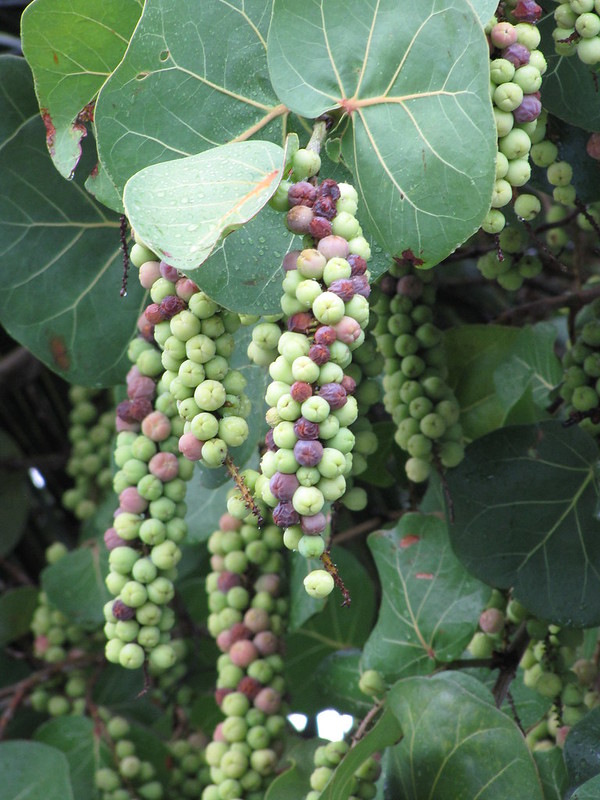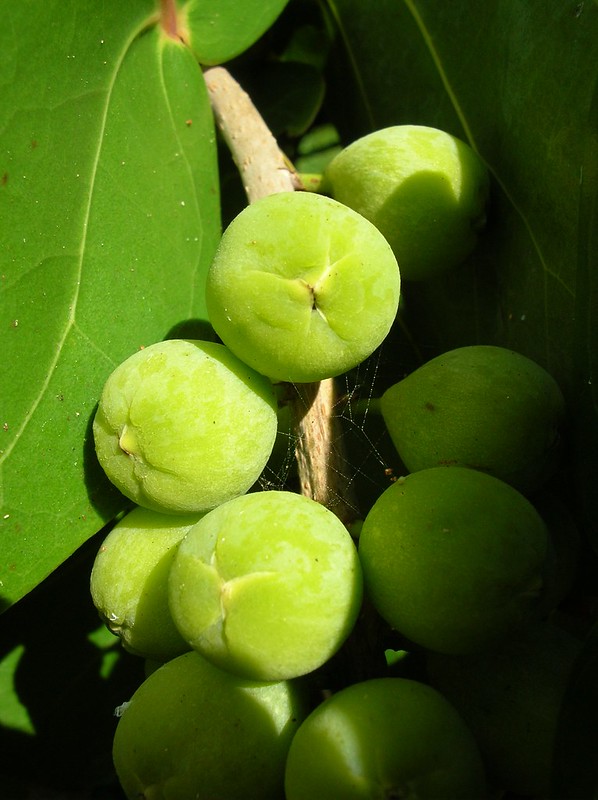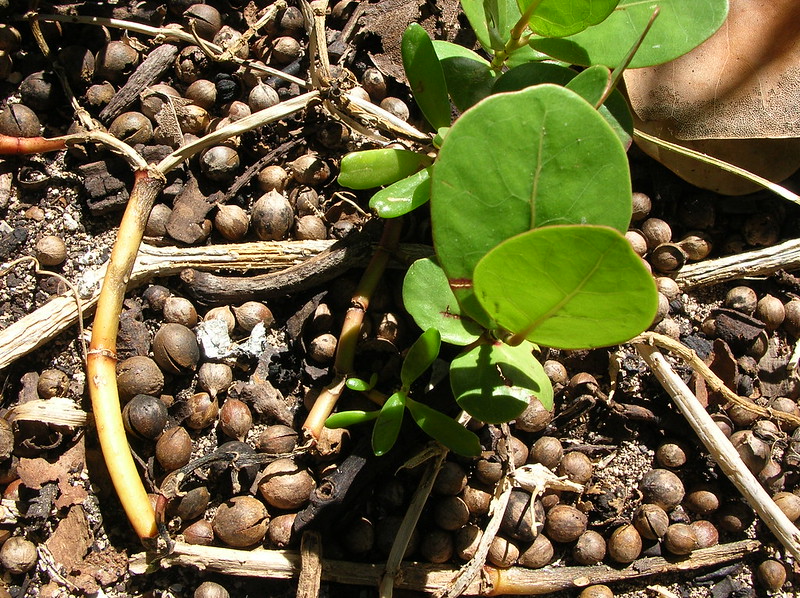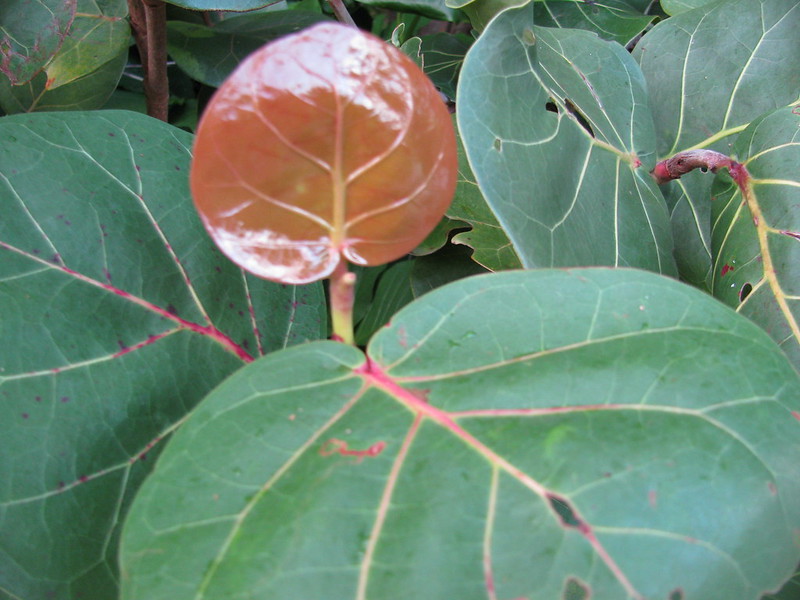L., Polygonaceae

|

|

|

|

|
|
L., Polygonaceae |
|
Present on Pacific Islands? yes
Primarily a threat at high elevations? no
Risk assessment results: High risk; score: 7 (Hawaii-Pacific Weed Risk Assessment for Coccoloba uvifera)
Other Latin names: Coccolobis uvifera (L.) Crantz; Polygonum uviferum L.
Common name(s): [more details]
|
English: Jamaican kino, platterleaf, sea grape, sea-grape, shore sea-grape |
Habit: shrub/tree
Description: "Evergreen shrub or small tree to 20' tall. Lvs nearly sessile; blades ±circular, usu broader than long, 3-8" x 5-12", thickly leathery, base cordate, apex rounded to notched, veins reddish. Infl racemes to 12" long. Flws white, fragrant.
Frt broadly ellipsoid to ±globose, to 0.75" ⌀, enclosed in fleshy, purplish floral receptacle, pulp astringent to sweet. Achene smooth, obtuse to sharply angled, hard." (A Tropical Garden Flora, p. 462)
Habitat/ecology: "Native to warm parts of America where it can be found in thickets along sandy shores (In Gardens of HawaiiNeal 1965)." (Midway Atoll Vascular Plant Checklist, p. 63)
"Native to sandy beaches and coastal strand . . . sea-grape is widely cultivated as a salt-tolerant plant for beach locations. . . . Sea-grape prefers sandy soils and is extremely tolerant of salt exposure, strong winds, and intense sun. It is used for xeriscaping in southern Florida." (A Tropical Garden Flora, p. 463)
Propagation: "Propagation is usually from seed, although selected cultivars must be propagated by cuttings or air layers to preserve their character." (A Tropical Garden Flora, p. 463)
Native range: "Native to warm parts of America where it can be found in thickets along sandy shores (In Gardens of HawaiiNeal 1965)." (Midway Atoll Vascular Plant Checklist, p. 63)
"Native to sandy beaches and coastal strand from Florida to northern Brazil. . . ." (A Tropical Garden Flora, p. 462)
Impacts and invaded habitats: (no invaded habitats or impacts known by PIER; please let us know if you know of such information we should add here)
Presence:
| Pacific | |||
|
Country/Terr./St. & Island group |
Location |
Cited status &
Cited as invasive & Cited as cultivated & Cited as aboriginal introduction? |
Reference &
Comments |
|
Cook Islands
Southern Cook Islands |
Rarotonga Island | Consortium of Pacific Herbaria (2018) | |
|
French Polynesia
French Polynesia Islands |
French Polynesia Islands | Consortium of Pacific Herbaria (2018) | |
|
French Polynesia
Marquesas Islands |
Fatu Hiva Island | Consortium of Pacific Herbaria (2018) | |
|
State of Hawaii
Hawaiian Islands |
Hawaiian Islands |
native
cultivated |
GRIN (year unknown)
accessed 20180615, ref. says "Cultivated" but doesn't specify where |
|
State of Hawaii
Hawaiian Islands |
Kaua‘i Island | Consortium of Pacific Herbaria (2018) | |
|
State of Hawaii
Hawaiian Islands |
Maui Island | Consortium of Pacific Herbaria (2018) | |
|
State of Hawaii
Hawaiian Islands |
Moloka‘i Island | Consortium of Pacific Herbaria (2018) | |
|
State of Hawaii
Hawaiian Islands |
O‘ahu Island | Consortium of Pacific Herbaria (2018) | |
|
Kiribati
Kiribati |
Kiribati (Republic of) | Consortium of Pacific Herbaria (2018) | |
|
Marshall Islands
Marshall Islands |
Ebeye Islet | Consortium of Pacific Herbaria (2018) | |
|
Pacific
Polynesia |
Polynesia (U.S.-administered islands) | Consortium of Pacific Herbaria (2018) | |
|
Pitcairn Islands
Pitcairn Islands |
Pitcairn Islands | Consortium of Pacific Herbaria (2018) | |
|
United States (other Pacific offshore islands)
Midway Atoll |
Midway Atoll | Consortium of Pacific Herbaria (2018) | |
|
United States (other Pacific offshore islands)
Wake Islands |
Wake Island | Consortium of Pacific Herbaria (2018) | |
| Pacific Rim | |||
|
Country/Terr./St. & Island group |
Location |
Cited status &
Cited as invasive & Cited as cultivated & Cited as aboriginal introduction? |
Reference &
Comments |
|
Central America
Central America (Pacific rim) |
Costa Rica (Republic of) |
native
cultivated |
GRIN (year unknown)
accessed 20180615, ref. says "Cultivated" but doesn't specify where |
|
Central America
Central America (Pacific rim) |
Honduras (Republic of) |
native
cultivated |
GRIN (year unknown)
accessed 20180615, ref. says "Cultivated" but doesn't specify where |
|
Central America
Central America (Pacific rim) |
Nicaragua (Republic of) |
native
cultivated |
GRIN (year unknown)
accessed 20180615, ref. says "Cultivated" but doesn't specify where |
|
Central America
Central America (Pacific rim) |
Panama (Republic of) |
native
cultivated |
GRIN (year unknown)
accessed 20180615, ref. says "Cultivated" but doesn't specify where |
|
Central America
Central America (non-Pacific rim) |
Belize |
native
cultivated |
GRIN (year unknown)
accessed 20180615, ref. says "Cultivated" but doesn't specify where |
|
Mexico
Mexico |
Mexico (United Mexican States) |
native
cultivated |
GRIN (year unknown)
accessed 20180615, ref. says "Cultivated" but doesn't specify where |
|
South America (Pacific rim)
South America (Pacific rim) |
Colombia |
native
cultivated |
GRIN (year unknown)
accessed 20180615, ref. says "Cultivated" but doesn't specify where |
|
South America (Pacific rim)
South America (Pacific rim) |
Ecuador |
native
cultivated |
GRIN (year unknown)
accessed 20180615, ref. says "Cultivated" but doesn't specify where |
| Indian Ocean | |||
|
Country/Terr./St. & Island group |
Location |
Cited status &
Cited as invasive & Cited as cultivated & Cited as aboriginal introduction? |
Reference &
Comments |
|
Seychelles
Seychelles Islands |
Seychelles Islands |
introduced
|
Invasive Species Specialist Group (2017) |
| Also reported from | |||
|
Country/Terr./St. & Island group |
Location |
Cited status &
Cited as invasive & Cited as cultivated & Cited as aboriginal introduction? |
Reference &
Comments |
|
Caribbean Islands
Caribbean Islands |
Antigua and Barbuda |
native
cultivated |
GRIN (year unknown)
accessed 20180615, ref. says "Cultivated" but doesn't specify where |
|
Caribbean Islands
Caribbean Islands |
Barbados |
native
cultivated |
GRIN (year unknown)
accessed 20180615, ref. says "Cultivated" but doesn't specify where |
|
Caribbean Islands
Caribbean Islands |
Dominican Republic |
native
cultivated |
GRIN (year unknown)
accessed 20180615, ref. says "Cultivated" but doesn't specify where |
|
Caribbean Islands
Caribbean Islands |
Grenada |
native
cultivated |
GRIN (year unknown)
accessed 20180615, ref. says "Cultivated" but doesn't specify where |
|
Caribbean Islands
Caribbean Islands |
Guadeloupe |
native
cultivated |
GRIN (year unknown)
accessed 20180615, ref. says "Cultivated" but doesn't specify where |
|
Caribbean Islands
Caribbean Islands |
Martinique |
native
cultivated |
GRIN (year unknown)
accessed 20180615, ref. says "Cultivated" but doesn't specify where |
|
Caribbean Islands
Caribbean Islands |
Montserrat |
native
cultivated |
GRIN (year unknown)
accessed 20180615, ref. says "Cultivated" but doesn't specify where |
|
United States of America
United States |
United States |
invasive
|
Holm, Leroy/Pancho, Juan V./Herberger, James P./Plucknett, Donald L. (1979) (p. 93)
(X)=present as a weed (but importance rank unknown) |
|
United States (continental except west coast)
United States (other states) |
USA (Florida) |
native
cultivated |
GRIN (year unknown)
accessed 20180615, ref. says "Cultivated" but doesn't specify where |
Comments: Present in Hawaii (Alien plant invasions in native ecosystems in Hawaii, p. 219; Midway Atoll Vascular Plant Checklist, p. 63)
Used as fruit-bearing windbreak component in Pacific Islands (Agroforestry Guides for Pacific Islands, p. 216)
Control: If you know of control methods for Coccoloba uvifera, please let us know.